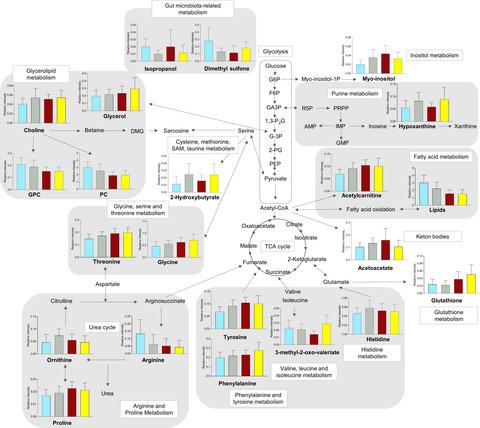当前位置:
X-MOL 学术
›
Ecol. Evol.
›
论文详情
Our official English website, www.x-mol.net, welcomes your feedback! (Note: you will need to create a separate account there.)
Integrating omics to characterize eco‐physiological adaptations: How moose diet and metabolism differ across biogeographic zones
Ecology and Evolution ( IF 2.6 ) Pub Date : 2021-03-04 , DOI: 10.1002/ece3.7265 Christian Fohringer 1 , Ilona Dudka 2 , Robert Spitzer 1 , Fredrik Stenbacka 1 , Olena Rzhepishevska 2 , Joris P. G. M. Cromsigt 1 , Gerhard Gröbner 2 , Göran Ericsson 1 , Navinder J. Singh 1
中文翻译:

整合组学以表征生态生理适应性:驼鹿的饮食和新陈代谢在生物地理区域之间如何不同
更新日期:2021-04-04
Ecology and Evolution ( IF 2.6 ) Pub Date : 2021-03-04 , DOI: 10.1002/ece3.7265 Christian Fohringer 1 , Ilona Dudka 2 , Robert Spitzer 1 , Fredrik Stenbacka 1 , Olena Rzhepishevska 2 , Joris P. G. M. Cromsigt 1 , Gerhard Gröbner 2 , Göran Ericsson 1 , Navinder J. Singh 1
Affiliation

|
- With accelerated land conversion and global heating at northern latitudes, it becomes crucial to understand, how life histories of animals in extreme environments adapt to these changes. Animals may either adapt by adjusting foraging behavior or through physiological responses, including adjusting their energy metabolism or both. Until now, it has been difficult to study such adaptations in free‐ranging animals due to methodological constraints that prevent extensive spatiotemporal coverage of ecological and physiological data.
- Through a novel approach of combining DNA‐metabarcoding and nuclear magnetic resonance (NMR)‐based metabolomics, we aim to elucidate the links between diets and metabolism in Scandinavian moose Alces alces over three biogeographic zones using a unique dataset of 265 marked individuals.
- Based on 17 diet items, we identified four different classes of diet types that match browse species availability in respective ecoregions in northern Sweden. Individuals in the boreal zone consumed predominantly pine and had the least diverse diets, while individuals with highest diet diversity occurred in the coastal areas. Males exhibited lower average diet diversity than females.
- We identified several molecular markers indicating metabolic constraints linked to diet constraints in terms of food availability during winter. While animals consuming pine had higher lipid, phospocholine, and glycerophosphocholine concentrations in their serum than other diet types, birch‐ and willow/aspen‐rich diets exhibit elevated concentrations of several amino acids. The individuals with highest diet diversity had increased levels of ketone bodies, indicating extensive periods of starvation for these individuals.
- Our results show how the adaptive capacity of moose at the eco‐physiological level varies over a large eco‐geographic scale and how it responds to land use pressures. In light of extensive ongoing climate and land use changes, these findings pave the way for future scenario building for animal adaptive capacity.
中文翻译:

整合组学以表征生态生理适应性:驼鹿的饮食和新陈代谢在生物地理区域之间如何不同
- 随着北部纬度地区土地转换和全球升温的加速,了解极端环境中动物的生活史如何适应这些变化变得至关重要。动物可以通过调节觅食行为或通过生理反应(包括调节其能量代谢)或两者进行适应。迄今为止,由于方法学上的制约因素阻止了对生态和生理数据的广泛时空覆盖,因此很难在自由放养的动物中研究这种适应性。
- 通过结合基于DNA元条形码和基于核磁共振(NMR)的代谢组学的新颖方法,我们旨在通过使用265个标记个体的独特数据集,阐明三个生物地理区域上斯堪的纳维亚驼鹿Alces alces的饮食与代谢之间的联系。
- 根据17种饮食项目,我们确定了四种不同类型的饮食类型,这些类型与瑞典北部各个生态区域中浏览物种的可利用性相匹配。北方地区的人们主要食用松树,饮食种类最少,而沿海地区的饮食种类最多。男性的平均饮食多样性低于女性。
- 我们鉴定了几种分子标记,这些标记指示在冬季食物供应方面与饮食限制相关的代谢限制。与其他饮食类型相比,食用松树的动物血清中的脂质,磷胆碱和甘油磷酸胆碱浓度更高,而桦树和柳/砷丰富的饮食中某些氨基酸的浓度升高。饮食多样性最高的人体内酮体水平增加,表明这些人长期处于饥饿状态。
- 我们的结果表明,驼鹿在较大的生态地理范围内在生态生理水平上的适应能力如何变化,以及它如何响应土地利用压力。鉴于持续不断的气候变化和土地利用变化,这些发现为将来建立动物适应能力的方案铺平了道路。



























 京公网安备 11010802027423号
京公网安备 11010802027423号